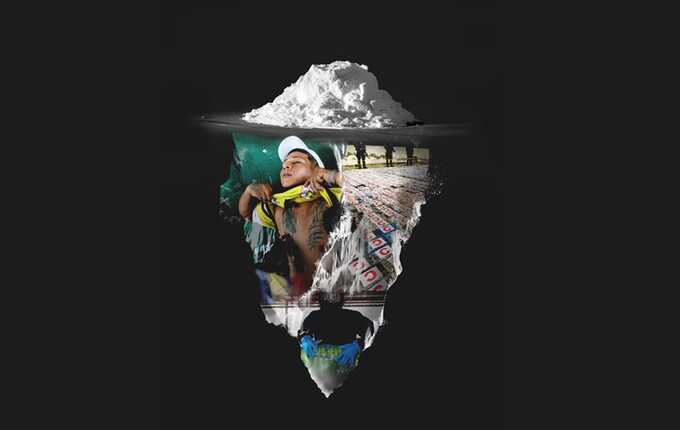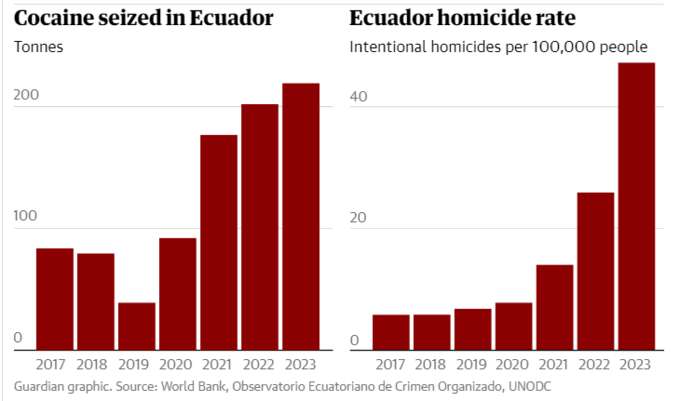’The cocaine superhighway’: the trail of death and destruction from South America to Europe

A sign on the doorway said “For rent” and the house’s lights were out. But the assault team were convinced a group of armed gang members lurked inside and they were determined to smoke them out.
As darkness enveloped Guayaquil, Ecuador’s largest city, six truckloads of military and police troopers screeched to a halt in front of the seemingly vacant home.
Some pummelled its front and side entrances with steel battering rams, crowbars and fists. Others scrambled up its outer wall.
Soon their hunch was confirmed. One suspect leapt from a second-floor window and ran across a corrugated roof. As the security forces finally stormed the house, a second man was wrestled to the ground inside a bedroom.
A third suspect was bundled to the living-room floor as the masked squad demolished the house’s interior in search of hidden guns and drugs. “Where’s the rifle?” one soldier bellowed as a half-naked prisoner was thrashed with a pole, leaving red streaks across his back.
Minutes later, the weapon was found stashed inside a child’s ransacked bedroom, along with a pistol and another US-made Mac-10 submachine gun. The girl sat at the kitchen table with her mother, fiddling anxiously with a toy.
The disturbing scenes unfolded in January, just a few hours after Ecuador’s president, Daniel Noboa, vowed to wage an unflinching “war” to prevent Ecuador becoming “a narco-state”. The two captured men were allegedly members of Los Águilas (the Eagles), one of 22 gangs and organised crime groups that Noboa accuses of bringing carnage to what was until recently one of South America’s most peaceful countries.
The raid was an unmistakably Latin American spectacle: the kind of scene that has played out in recent years from Tijuana, on the Mexican-US border, to Rio de Janeiro as part of a bloody and largely ineffectual battle against the illegal drug trade. But it was also a scene umbilically linked to European cities thousands of miles away, where soaring demand for cocaine from South America has helped make cities such as Guayaquil some of the most violent on Earth.
Ecuador is not a cocaine producer – that work is performed almost entirely in three other South American nations: Colombia, Peru and Bolivia. But over the past five years, Ecuador’s bustling Pacific ports have become a crucial shipment point for cocaine-filled containers being smuggled to the US and Europe, turning Ecuador into a “cocaine superhighway”.

Officers guard more than 21 tonnes of drugs, which were seized from a farm in the city of Vinces in Los Rios province, January 2024. Photograph: Imago/Alamy
Bob Van den Berghe, deputy head of the passenger and cargo border team at the United Nations Office on Drugs and Crime, says people in Europe need to wake up to the pain they are causing on the other side of the world.
“If someone is consuming one gram of cocaine [they should be] aware that it doesn’t end up on the market just like that. There’s a story behind it – which is not a very nice story. In fact, it might even be quite a bloody story.”
Van den Berghe says that of 220 tonnes of cocaine seized last year by authorities in Latin America and the Caribbean, 84% was bound for Europe and about 37% was recovered in Ecuador.

About 45 tonnes were heading to the port of Antwerp, which in recent years has become the European capital of cocaine smuggling, while 40.5 tonnes were going to Rotterdam in the Netherlands, 38.5 tonnes to Hamburg in Germany and 34 tonnes to Valencia in Spain. “These are the four main ports,” says Van den Berghe, a former member of Belgium’s federal police, who trains police and customs officers to identify “high-risk consignments” before they set off for Europe.
Rising cocaine consumption in Europe, which Belgian authorities have called a “tsunami”, has brought violence to several of the European port cities where such illegal shipments arrive. Over the past five years in Antwerp, where a record 116 tonnes of cocaine were seized at the port last year, there have been shootings, arson attacks and bombings as organised crime groups vie for control.
In a sign of mounting European concern over the impact of organised crime, the mayors of Antwerp, Hamburg and Rotterdam recently travelled together to Ecuador’s capital, Quito, to discuss the fight against drug-related crime.
“Your problem is also our problem,” Bart De Wever, the nationalist mayor of Belgium’s second-largest city, told Noboa, admitting European drug use was “at the root of criminality” in Ecuador.
For all the problems that drug trafficking is causing in Europe, the violence blighting the streets of Guayaquil is undeniably worse, as gangs such as Los Águilas battle it out for control of the streets and smuggling routes. In recent years scarcely a day has gone by without corpse collectors picking up at least one body from the streets.
Luis Chonillo, mayor of the neighbouring port city, Durán, has spent almost a year moving between safe houses after an attempt to assassinate him on the day of his inauguration last year. “Today we are facing a second major nationwide pandemic – which is called insecurity,” he says, speaking from a refuge in the mountains outside town. Ecuador’s murder rate almost doubled between 2022 and 2023, when more than 8,000 murders made it the most violent country in Central and South America.
Glaeldys González, an International Crisis Group expert, says Guayaquil’s highly strategic location – and longstanding trade ties with Europe – have placed it and the surrounding province of Guayas in the eye of Ecuador’s storm. At least six criminal groups have spent recent years fighting over access to the region’s ports, from which huge shipments of bananas are sent to Europe each year – and with them large stashes of cocaine.

Ecuador’s Special Mobile Anti-narcotics Group patrols the Port of Guayaquil. Photograph: Bloomberg/Getty Images
That strategic position has attracted the attention of two of Mexico’s most powerful cartels, Sinaloa and the Jalisco New Generation cartel, which have allied themselves with Ecuadorian partners through which they are fighting a proxy war in the streets of cities such as Guayaquil.
The Sinaloan group has reportedly thrown its weight behind an Ecuadorian faction called Los Choneros while the Jalisco cartel is said to have backed a rival called Los Lobos (The Wolves). In April, Noboa named the head of the Sinaloa cartel, Ismael “El Mayo” Zambada Garcia, as one of the top military objectives of his fight against “narco-terrorists”.
González says it is unclear how Mexican cartel bosses would react to Noboa’s crackdown, Plan Phoenix, in which more than 18,000 people have been arrested and nearly 5,000 guns seized, according to government figures. “We don’t know if these Mexican groups are still going to want to be involved [with their Ecuadorian partners] because this obviously affects their business and it affects shipping, it affects the flow of money,” she says.
For now the bloodshed goes on. After a lull in the weeks after Noboa declared a 90-day state of emergency in January, there has been a rise in violence with scores of killings over Easter, including a massacre during a game of volleyball in Guayaquil in which 10 people were killed.
As he tours Socio Vivienda, one of the poor Guayaquil communities controlled by another of Noboa’s targets – the leader of the Los Tiguerones (The Tigers) gang, nicknamed Commander Willy – a local police officer, Jorge Alexander Masache Novillo, 29, urges European drug users to think about the impact of their habit.
“They need to understand the damage their consumption is causing and the damage they are doing to our country,” he says.
Words by Tom Phillips in Guayaquil. Data and visuals by Ana Lucía González Paz, Lucy Swan and Harvey Symons
Read more similar news:
Comments:
comments powered by Disqus

































